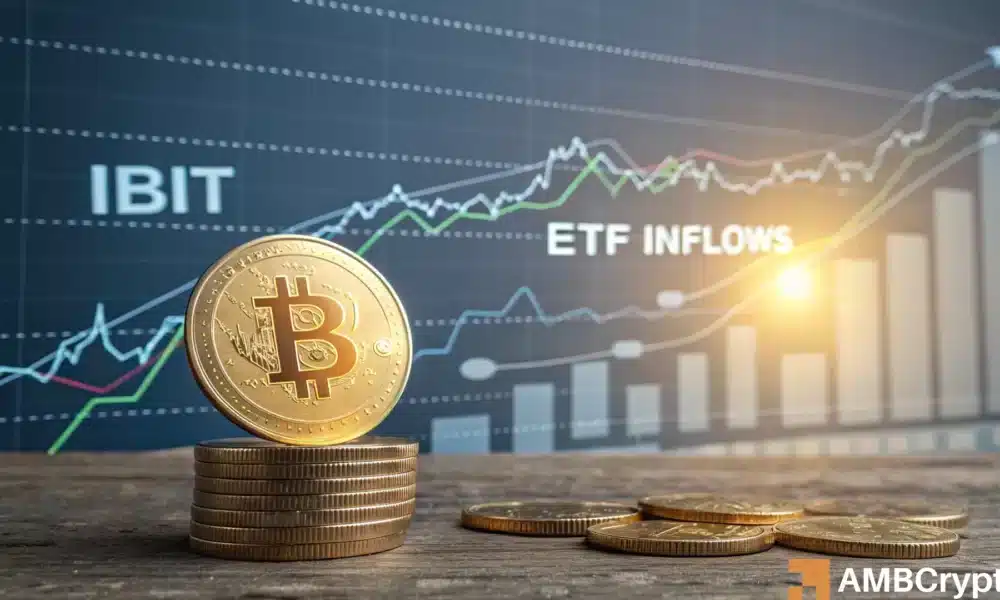Unpacking the Role of Bitcoin ETFs in Market Stability and Growth
Bitcoin (BTC) has long been regarded as a volatile asset, often driven by market speculation and sentiment. However, recent developments have highlighted a new source of stability for the cryptocurrency: Exchange-Traded Funds (ETFs). This year, U.S. spot Bitcoin ETFs have demonstrated remarkable resilience, with steady inflows indicating strong institutional and retail demand despite the market’s inherent volatility. Notably, BlackRock’s IBIT ETF has emerged as a leader among these products, amassing over $2.4 billion in inflows year-to-date (YTD), making it a standout player in the ETF market and a potential harbinger of Bitcoin’s future stability.
The growth in ETF participation has noticeably reduced long-term volatility for Bitcoin. The influx of funds into these ETFs has absorbed much of the sell-side pressure typically associated with cryptocurrency markets. Recent trends show that existing Bitcoin holders, particularly those with weaker hands influenced by the FTX collapse and other selling events, are being supplanted by more stable, long-term investors who are willing to weather market fluctuations. Continual accumulation by market leaders like Michael Saylor and MicroStrategy has further solidified this trend, helping to maintain Bitcoin’s price within a range of $60K to $70K, limiting sharp price corrections typically associated with speculative trading.
Furthermore, significant selling pressure has been alleviated by a shift in the demography of Bitcoin holders. In the past 15 months, many sellers in the market, including those affected by the FTX collapse and arbitrage traders from the Grayscale Bitcoin Trust (GBTC), have offloaded their assets. This has opened up opportunities for new investors who are more committed to the long-term potential of Bitcoin. ETF holders, who generally adopt a more cautious, long-term investment strategy, are distancing themselves from short-term traders prone to panic selling. As a result, Bitcoin is becoming less reactive to daily macroeconomic developments and altcoin dynamics, which have historically influenced its price.
The increasing concentration of Bitcoin ownership among institutional investors and committed long-term holders suggests a potential structural change in the market. With an uptick in ETF holdings, the traditional risk assets correlation might weaken, leading Bitcoin to evolve into a less speculative asset. This change could align Bitcoin more closely with established capital flows, rather than solely mirroring crypto-native sentiments. Hence, as the landscape shifts, the narrative surrounding Bitcoin is gradually transforming from one that showcases volatility to one that embraces stability.
Historically, Bitcoin’s price has struggled with rapid consolidation periods, often signaling impending breakout opportunities. At present, Bitcoin is trading just above $80K, showcasing resilience amid this structural shift. The sustained inflows into Bitcoin ETFs like IBIT could act as a catalyst for a significant price increase, suggesting that if this trend continues, a breakout may soon be on the horizon. Investors are keenly observing these inflows as they could foreshadow a shift in Bitcoin’s market dynamics towards a more robust and sustained upward trajectory.
Looking ahead, the rising interest in Bitcoin ETFs symbolizes a maturing market for the cryptocurrency. The regulatory approvals and increased participation reflect a strengthening infrastructure poised for future growth. As more capital flows into this asset class through regulated channels, it is likely to attract a wider audience and foster confidence among new investors. The potential for Bitcoin to thrive in a more stable environment while also capturing institutional interest could redefine how both new and seasoned investors approach this digital asset.
In conclusion, the role of Bitcoin ETFs in providing market stability cannot be overstated. With significant inflows signaling strong and growing investor conviction, Bitcoin is poised for a new chapter. This integration of traditional financial structures into crypto markets may reshape perceptions and pave the way for Bitcoin to solidify its status as a long-term store of value rather than merely a speculative instrument. As we look to the future, the implications of these changes could reverberate throughout the broader market, marking Bitcoin’s transition into a more stable and institutional-friendly asset.


